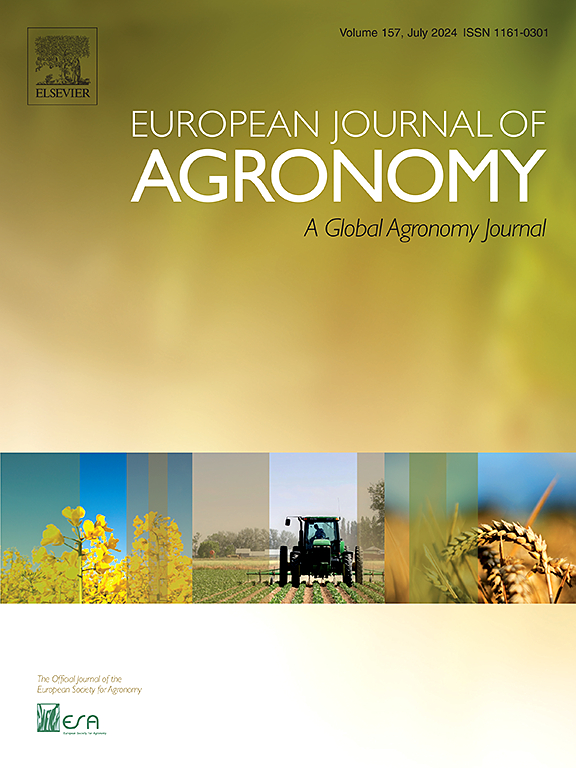On-farm insights in the South American Gran Chaco reveal the importance of soil organic matter and crop management decisions for boosting maize yields
IF 4.5
1区 农林科学
Q1 AGRONOMY
引用次数: 0
Abstract
Soybean monoculture is widespread across recently deforested areas in South America, leading to a decline in soil organic matter (SOM) and compromising the sustainability of the cropping system. Introducing cereals like maize into the crop rotation is necessary, but proper management knowledge to maximize its yield and profitability is needed. Our objectives were to quantify the impact of management and environmental variables influencing maize yield and estimate the potential to increase attainable yields in recently deforested fields of South American Gran Chaco. The analysis included a total of 62 on-farm trials across multiple environments, each including 9–28 hybrids. The mean site yields ranged from 2235 to 11141 kg ha−1. Using linear mixed models, we identified and tested a model with key management and environmental variables explaining yield variation. We used this model to estimate attainable yields across the region. Nitrogen availability, sowing date, and hybrid type (temperate or sub-tropical) were the most important management variables to predict yield (relative importance ≥ 0.80). Soil organic matter and soil water availability at sowing were the most important environmental yield predictors (relative importance of 0.71 and 0.66, respectively). The best model, tested against an independent dataset (n = 34 trials; RMSE=1722 kg ha−1; RRMSE=21 %) confirmed the influence of defined predictors. Our findings demonstrate that simple management adjustments can boost yields by ∼20 % (∼1500 kg ha−1). In this recently deforested region, the decline in SOM and its negative impact on yields highlight the importance of crop management strategies and policies aimed at improving current cropping systems.
南美洲大查科的农场洞察揭示了土壤有机质和作物管理决策对提高玉米产量的重要性
大豆单一栽培在南美洲最近被砍伐的地区广泛存在,导致土壤有机质(SOM)下降,损害了种植系统的可持续性。将玉米等谷物引入作物轮作是必要的,但需要适当的管理知识,以最大限度地提高其产量和盈利能力。我们的目标是量化影响玉米产量的管理和环境变量的影响,并估计南美大查科最近森林砍伐的地区提高可实现产量的潜力。该分析包括在多个环境中进行的总共62项农场试验,每个试验包括9-28种 杂交品种。平均产率为2235 ~ 11141 kg ha−1。利用线性混合模型,我们确定并检验了一个具有关键管理和环境变量解释产量变化的模型。我们用这个模型来估计整个地区的可实现产量。氮素有效性、播期和杂交类型(温带或亚热带)是预测产量最重要的管理变量(相对重要性≥0.80)。播期土壤有机质和土壤水分有效性是最重要的环境产量预测因子(相对重要性分别为0.71和0.66)。最佳模型,针对独立数据集进行测试(n = 34次试验;RMSE = 1722 公斤 公顷−1;RRMSE=21 %)证实了定义的预测因子的影响。我们的研究结果表明,简单的管理调整可以使产量提高~ 20 %(~ 1500 kg ha−1)。在这一最近森林被砍伐的地区,SOM的下降及其对产量的负面影响凸显了旨在改善现有种植制度的作物管理战略和政策的重要性。
本文章由计算机程序翻译,如有差异,请以英文原文为准。
求助全文
约1分钟内获得全文
求助全文
来源期刊

European Journal of Agronomy
农林科学-农艺学
CiteScore
8.30
自引率
7.70%
发文量
187
审稿时长
4.5 months
期刊介绍:
The European Journal of Agronomy, the official journal of the European Society for Agronomy, publishes original research papers reporting experimental and theoretical contributions to field-based agronomy and crop science. The journal will consider research at the field level for agricultural, horticultural and tree crops, that uses comprehensive and explanatory approaches. The EJA covers the following topics:
crop physiology
crop production and management including irrigation, fertilization and soil management
agroclimatology and modelling
plant-soil relationships
crop quality and post-harvest physiology
farming and cropping systems
agroecosystems and the environment
crop-weed interactions and management
organic farming
horticultural crops
papers from the European Society for Agronomy bi-annual meetings
In determining the suitability of submitted articles for publication, particular scrutiny is placed on the degree of novelty and significance of the research and the extent to which it adds to existing knowledge in agronomy.
 求助内容:
求助内容: 应助结果提醒方式:
应助结果提醒方式:


